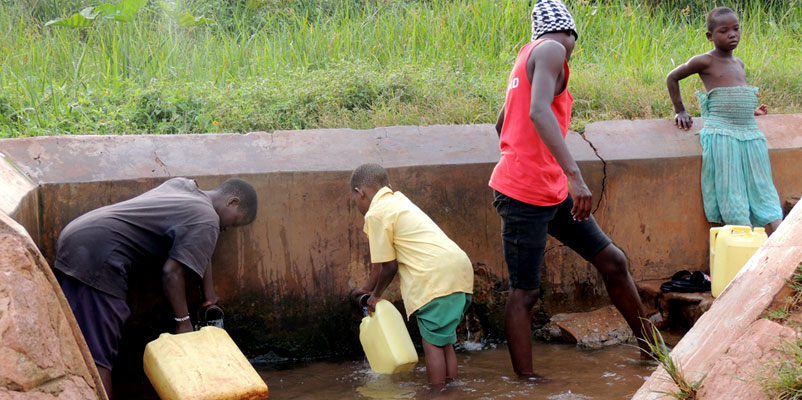human traffickingFeatures
Can groundwater reserves solve water scarcity?
The water trapped beneath the earth’s surface in Africa is more plentiful and cleaner than surface water. The key is regulation and cooperation.
Travelling across rural Uganda, one is sure to see women, men and children carrying jerry cans on their heads or bicycles. They are usually on their way to or from a well to collect water. It’s the way thousands of households across the country access the water they need to survive.
However, many of these wells can become infected or dry up. And with the effects of climate change making droughts more frequent, thousands of people are being forced to walk miles each day in search of clean water, while others settle for dirty water in streams and rivers.
Yet, the answer to this water shortage could lie beneath the ground.
There is now a growing awareness that groundwater could provide the key to the issue of water scarcity in many parts of the Nile Basin.
Poor access to water is not only a threat to people’s health but also livelihoods. It limits the potential to irrigate crops or undertake other water-dependent activities such as agro-processing and livestock farming.
The need for greater access to reliable and clean water has therefore risen to the top of the development agenda of many countries in the Nile Basin in recent years. These countries recognise that the pressure on water resources will only grow, due to the ambitious economic development plans of the member countries of the Nile Basin ranging from energy generation, irrigation, industrial use, oil development as well as conservation.
Studies by researchers at the Nile Basin Secretariat show that the combined effect of the ambitious development plans of the 10 Nile Basin member countries will cause significant water stress in the region as soon as five years from now.
In light of the growing demand for water, these countries have come together under auspices of the Nile Basin Initiative (NBI) to discuss ways to increase cooperation and understanding of the water resources in an effort to promote their sustainable utilisation and development.
Lakes underneath much of Africa
An increasingly important focus is the question of how best to access and utilise the groundwater trapped beneath the earth’s surface. Groundwater is the water held in interconnected spaces between rocks lying beneath the surface in basin-shaped rocks known as aquifers.
According to Dr. Callist Tindimugaya, a hydro-geologist working in the ministry of water, replenishment or recharge of most groundwater reserves also known as aquifers, is done by rainfall. However, desert or arid countries such as Egypt, Lybia, Sudan also hold substantial amounts of groundwater that has been stored there for thousands of years when those places still experienced rainfall.
Significantly, there is growing scientific evidence that most African countries, including those in the Nile Basin, possess a considerable number of aquifers. Since shallow aquifers can easily be depleted through over-abstraction, the focus is now shifting towards the deeper aquifers that contain larger reserves. And technological advancements are making it easier to locate and exploit these reserves.
Mapping underground resources
In 2013, researchers using satellite and radar technology discovered aquifers in the arid Turkana and Lotikipi Basins of northern Kenya. The two aquifers were found to hold some 250 billion cubic meters of water, enough to meet Kenya’s water needs for nearly 70 years.
The previous year, researchers from the British Geological Survey and University College London announced that they had mapped in detail the amount and potential yield of groundwater resources across the continent. They found that the total volume of water in underground aquifers was 100 times the amount found on the surface.
Rainfall is the biggest source of water for replenishing the aquifers. With many aquifers not being filled due to a lack of rain, the scientists said at the time of their report that they were concerned large-scale borehole developments could rapidly deplete the resource.
Groundwater can be accessed more reliably
The biggest aquifers are thought to exist in the desert countries of North Africa: Algeria, Egypt, Libya and Sudan. There are, however, several relatively smaller aquifers located across the continent.
In Uganda, the state-owned water utility, the National Water and Sewerage Corporation (NWSC), is working in conjunction with the Ministry of Water and Environment on a major drive to supply urban and rural areas with safe water. Groundwater is increasingly being looked at as a potential source because of its numerous advantages over surface water.
For a start, groundwater can be accessed more reliably all year round and there is little cost involved in treating it. According to Chris Tumusiime, the assistant commissioner for rural water supply at the Ministry of Water and Environment, the biggest challenge with groundwater is the initial cost of drilling and installing the pumps.
In the long run, however, this is still cheaper than treating surface water, he says. “The biggest problem is if you take more water than the basin is able to recharge,” he explained. “There is a certain level beyond which you cannot abstract any more water.”
NWSC spokesman Samuel Apedel explains that in Uganda they have been able to find aquifers a few meters beneath the surface in many parts of the country. “Uganda is so blessed,” he said. “Wherever you see a borehole, it is the first sign that there is groundwater. This also means that if further explored by experts, chances of finding much bigger reserves are high.”
According to Apedel, groundwater contributes between 25 and 30 percent of the NWSC’s overall water supply annually.
Groundwater is likely to receive even more attention in coming decades as organisations like the NWSC seek to deal with the rising levels of pollution in surface water bodies such as Lake Victoria.
According to Apedel, the unplanned expansion of urban settlements around the capital Kampala has significantly contributed to the rising pollution of Lake Victoria. That has caused a rise in the cost of treating water before it is piped across the city and its suburbs.
Data from Uganda’s Ministry of Water and Environment shows that the demand for water in the country will rise by nearly 80 percent by 2030. The existence of significant groundwater reserves
in different parts of the country, and indeed the wider region, offers great promise for the successful realisation of development plans, particularly ambitions to turn the region into the food basket of the continent through irrigated agriculture.
Robust regulation
At the same time, experts warn that if mismanaged, the reserves could be quickly depleted. Sustainable utilisation of water resources requires a robust regulatory regime to prevent over-abstraction.
For example, Uganda’s Ministry of Water and Environment operates a regulatory framework that only allows the abstraction of groundwater by individuals or organisations after a survey has been carried out by a registered hydro-geologist and a payment made for a permit for each well.
“Once the safe yield of water well is known, the government regulates the amount of water to be abstracted by stating it in the water permit,” explains Edward Rwarinda, the principal water officer responsible for regulations at the Ministry for Water and Environment. The permits cost approximately $125, and each motorised pump is issued with a unique identification number and a meter to facilitate prompt inspection.
However, Rwarinda admits that abstraction permits are only required for motorised pumps and not for hand pumps. That means that despite the regulations, unregulated abstraction is also being carried out.
While the groundwater is cleaner than surface water, extracting it without experts testing the mineral content carries health risks. According to Christine Mukwaya, an expert in groundwater at the Directorate of Water Resources Management (DWRM), some aquifers in Uganda have been found to contain too much iron, fluoride or other chemicals that can cause illnesses.
A 2001 report by the British Geological Survey for WaterAid, a UK charity, found that iron and manganese were a major problem associated with groundwater in Uganda. The researchers noted that the high concentration of fluoride in the rift valley region of Western Uganda as well as in the east around Mbale, was a major reason behind the high incidences of fluorosis, a condition characterised by damage to teeth due to excessive ingestion of fluoride.
Cooperation no longer a choice
The existence of huge underground water reserves has increased the need for the Nile Basin countries to cooperate to achieve the sustainable utilisation of water resources.
Cooperation is crucial as some of the aquifers straddle borders, while the location of others in very remote areas makes the joint development of water resources by neighbouring countries much more cost-effective than establishing parallel water transport infrastructures.
What is clear is that groundwater promises to be an important alternative source of water in the Nile Basin. Faced with rapidly rising demand as well as the vagaries of climate change, the realisation of this potential could unlock many opportunities for the development of these countries and possibly the entire continent.
This story was published by The Niles Newspaper
Comments




























